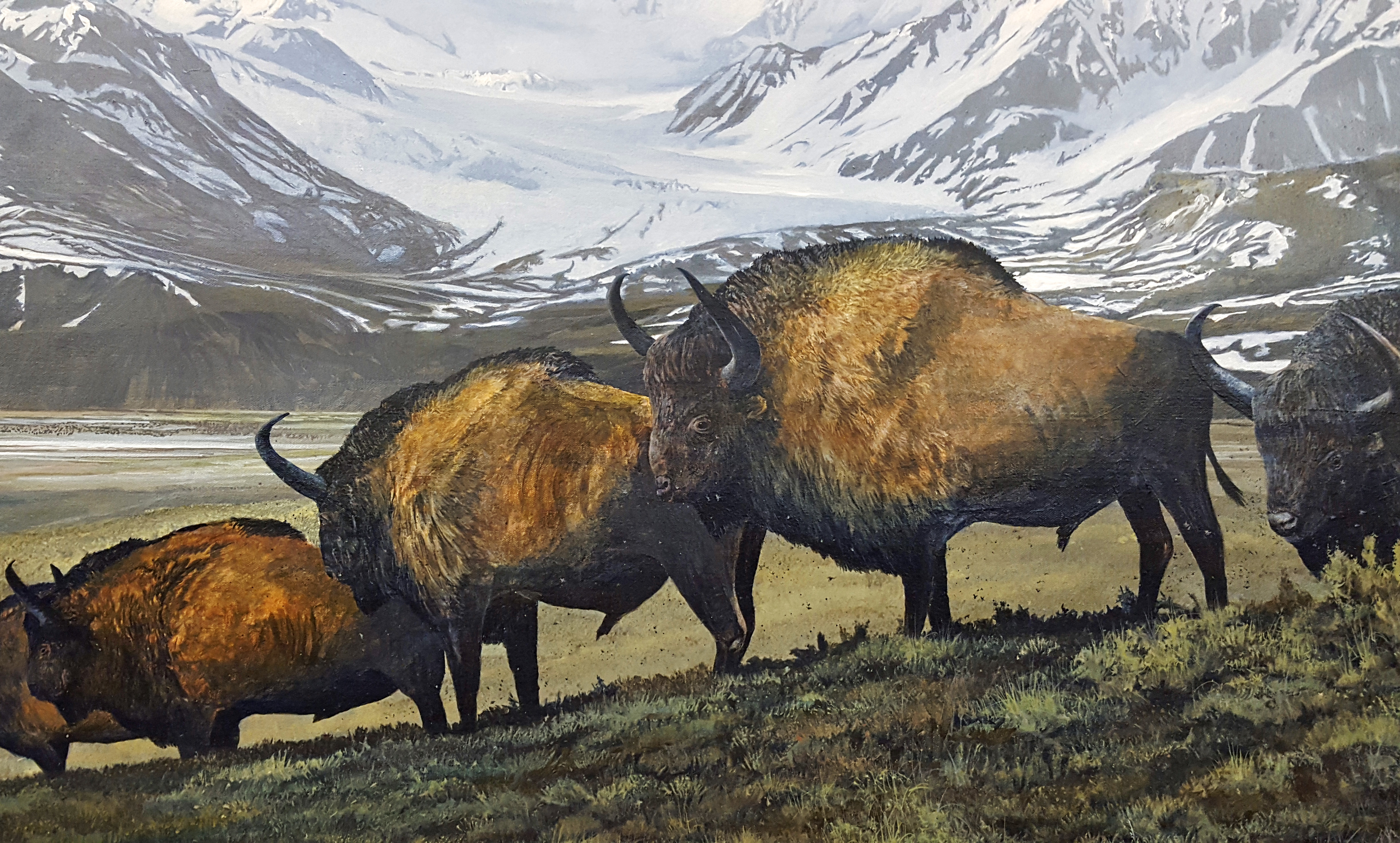Pleistocene painting showcases life in ancient Alaska
June 14, 2017
Theresa Bakker
907-474-6941
A large painting now on display at the University of Alaska Museum of the North depicts a scene from Alaska during the Pleistocene epoch, around 20,000 years ago.
The painter, Fairbanks artist Randall Compton, was already known for his landscapes and bird paintings when he began depicting local scenes from the ice age.
“It's fascinating to imagine large woolly mammoths roaming around the Fairbanks area,” Compton said. “I found it extremely interesting the more I researched in an effort to keep the illustrations scientifically accurate.”
The painting, “Heading for the River,” looks toward a glacier in the Alaska Range. The large, 14-foot long portrait captures a herd of steppe bison and several woolly mammoths as they meander down a tundra hillside toward a river, the snowy mountains glowing in the distance.
Compton said he began working in this genre after receiving a large commission from Dr. Stephen Sutley that kept him busy for the past decade. Sutley and his wife, Maree Barney Sutley, recently donated three paintings to the museum from their extensive collection of original artworks by Compton. The artwork had been on display in the Alaska Oral and Facial Surgery Center, which has recently changed owners as the couple begins their retirement.
Patrick Druckenmiller, the museum’s curator of earth sciences, said the artist captures an iconic Alaskan scene. “If it weren't for talented artists like Randall to pull together the details and bring this to light, the public and scientists alike would have no opportunity to really visualize this piece of Alaska history,” he said.
Druckenmiller said Interior Alaska was ice-free during periods when glaciers covered areas farther south. The animals converged into one region dense with wildlife, both prey and predator, much like an African savanna. These grasslands supported a diverse array of ice age mammals, such as woolly mammoth, steppe bison, horses, Beringian lions and short-faced bears.

Compton worked with specialists like paleontologist Dale Guthrie, who excavated the museum’s steppe bison known as Blue Babe, to make the animals as accurate as possible based on the abundance of fossils found in Alaska.
Druckenmiller said he has often wondered what a scene from that time period would have looked like.
“It's fascinating to ponder how different Alaska was only a few short thousands of years ago,” he said. “While the landscape is recognizable, the conspicuous fauna and flora were vastly different. Understanding the degree of differences is scientifically fascinating and provides a good lesson on how fast and how far things can change.”
The Sutleys donated three different paintings to the museum. One called “Flush” features a pair of woolly mammoths cresting a ridge backed by several Alaska Range peaks while a flock of ptarmigan and an Arctic gyrfalcon scatter from the tundra in front of them.
Another painting titled “Blue Babe” shows three Beringian lions attacking a steppe bison on the Alaska tundra. This painting depicts the story behind the well-known specimen that has been on display at the UA Museum of the North since 1980. The mummified remains of the steppe bison were discovered north of Fairbanks in 1979 when gold miners using a high pressure water gun spotted its feet sticking out of the mud.
Compton imagined how the attack would occur by studying modern lions who hunt in prides.
“A hundred years from now, I hope this painting will still fuel imaginations as to what it was like long ago during the ice age," he said. "I want people to get a feel of what it could have been like on a hot summer day thousands of years ago among the mosquitoes, the bison and the cool breezes from the snow-covered mountains during the Pleistocene.”
ADDITIONAL CONTACTS: Randall Compton, artist, at 907-750-1039 or via email at randallcomptonart@icloud.com; and Patrick Druckenmiller, UAMN earth sciences curator, at 907-474-6954 or via email at psdruckenmiller@alaska.edu


